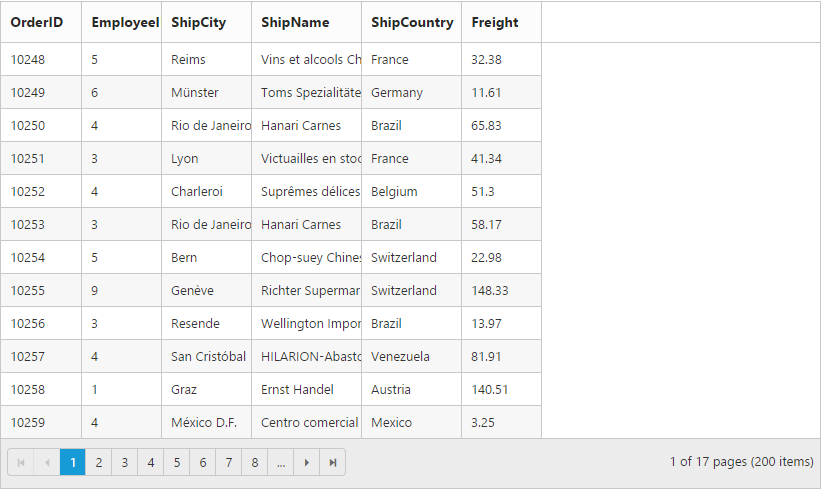Columns in ASP.NET Webforms Grid
20 Apr 202324 minutes to read
Column definitions are used as the DataSource schema in Grid and it plays vital role in rendering column values in required format. Grid operations such as sorting, filtering, editing would be performed based on the column definitions. The Field property of the Columns is necessary to map the datasource values in Grid columns.
NOTE
- If the column with
Fieldis not in the datasource, then the column values will be displayed as empty.- If the
Fieldname contains “dot” operator then it is considered as complex binding.
Auto generation
The Columns are automatically generated when Columns declaration is empty or undefined while initializing the Grid. Also, all the columns which are in DataSource are bound as a Grid columns.
The following code example shows auto-generate columns behavior.
<asp:Content ID="BodyContent" ContentPlaceHolderID="MainContent" runat="server">
<ej:Grid id="FlatGrid" runat="server" AllowPaging="true">
</ej:Grid>
</asp:Content>namespace WebSampleBrowser.Grid
{
public partial class _Default : Page
{
List<Orders> order = new List<Orders>();
protected void Page_Load(object sender, EventArgs e)
{
BindDataSource();
}
private void BindDataSource()
{
int orderId = 10643;
int empId = 0;
for (int i = 1; i < 9; i++)
{
order.Add(new Orders(orderId + 1, empId + 1,"Reims", 32.38, "Germany"));
order.Add(new Orders(orderId + 2, empId + 2,"Munster", 11.61, "Mexico"));
order.Add(new Orders(orderId + 3, empId + 3,"Rio de janerio" , 45.34, "Mexico"));
order.Add(new Orders(orderId + 4, empId + 4,"Lyon",37.28, "UK"));
order.Add(new Orders(orderId + 5, empId + 5,"Bern", 67.00, "Sweden"));
order.Add(new Orders(orderId + 6, empId + 6,"Graz", 23.32, "France"));
orderId += 6;
empId += 6;
}
this.FlatGrid.DataSource = order;
this.FlatGrid.DataBind();
}
[Serializable]
public class Orders
{
public Orders()
{
}
public Orders(int orderId, int empId, string shipCity,double freight, string shipCountry)
{
this.OrderID = orderId;
this.EmployeeID = empId;
this.ShipCity = shipCity;
this.ShipCountry = shipCountry;
this.Freight = freight;
}
public int OrderID { get; set; }
public int EmployeeID { get; set; }
public string ShipCity { get; set; }
public string ShipCountry { get; set; }
public double Freight { get; set; }
}
}
}The following output is displayed as a result of the above code example.
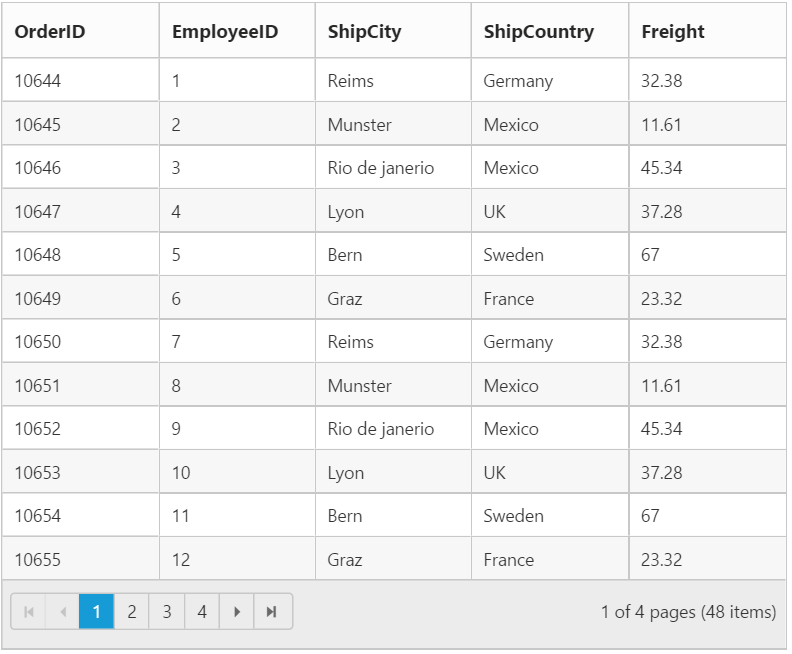
How to set isPrimaryKey for auto generated columns when editing is enabled:
Using DataBound event, you can set IsPrimaryKey value as true by two ways. The following code example demonstrates the above behavior.
- If primary key “column index” is known then refer the following code example
<asp:Content ID="BodyContent" ContentPlaceHolderID="MainContent" runat="server">
<ej:Grid ID="FlatGrid" runat="server" AllowPaging="true" >
<ClientSideEvents Databound="dataBound" />
<EditSettings AllowEditing="true"></EditSettings>
</ej:Grid>
</asp:Content><script type="text/javascript">
function dataBound(args) {
var column = args.model.columns[0];
//(or)
var column = this.getColumnByIndex(0);
column.isPrimaryKey = true;
//Here columns method used to update the particular column
this.columns(column, "update");
}
</script>namespace WebSampleBrowser.Grid
{
public partial class _Default : Page
{
protected void Page_Load(object sender, EventArgs e)
{
var data = new NorthWindDataContext().Orders.ToList();
FlatGrid.DataSource = data;
FlatGrid.DataBind();
}
}
}- If primary key “column field name” is known then refer the following code example
<asp:Content ID="BodyContent" ContentPlaceHolderID="MainContent" runat="server">
<ej:Grid ID="FlatGrid" runat="server" AllowPaging="true" >
<ClientSideEvents Databound="dataBound" />
<EditSettings AllowEditing="true"></EditSettings>
</ej:Grid>
</asp:Content><script type="text/javascript">
function dataBound(args) {
var column = this.getColumnByField("OrderID");
column.isPrimaryKey = true;
//Here columns method used to update the particular column
this.columns(column, "update");
}
</script>namespace WebSampleBrowser.Grid
{
public partial class _Default : Page
{
protected void Page_Load(object sender, EventArgs e)
{
var data = new NorthWindDataContext().Orders.ToList();
FlatGrid.DataSource = data;
FlatGrid.DataBind();
}
}
}Headers
HeaderText
It represents the title for particular column. To enable header text, set HeaderText property of Columns. The following code example describes the above behavior.
NOTE
If
HeaderTextis not defined then theFieldname is considered as header text for that particular column. If bothFieldname andHeaderTextare not defined then the column is rendered with “empty” header text.
The following code example describes the above behavior.
<asp:Content ID="BodyContent" ContentPlaceHolderID="MainContent" runat="server">
<ej:Grid ID="FlatGrid" runat="server" AllowPaging="true">
<Columns>
<ej:Column Field="OrderID" HeaderText="Order ID" />
<ej:Column Field="EmployeeID" HeaderText="Emp ID" />
<ej:Column Field="Freight" HeaderText="Freight" />
<ej:Column Field="ShipCountry" HeaderText="Country" />
<ej:Column Field="ShipCity" HeaderText="City" />
</Columns>
</ej:Grid>
</asp:Content>namespace WebSampleBrowser.Grid
{
public partial class _Default : Page
{
protected void Page_Load(object sender, EventArgs e)
{
var data = new NorthWindDataContext().Orders.ToList();
FlatGrid.DataSource = data;
FlatGrid.DataBind();
}
}
}The following output is displayed as a result of the above code example.
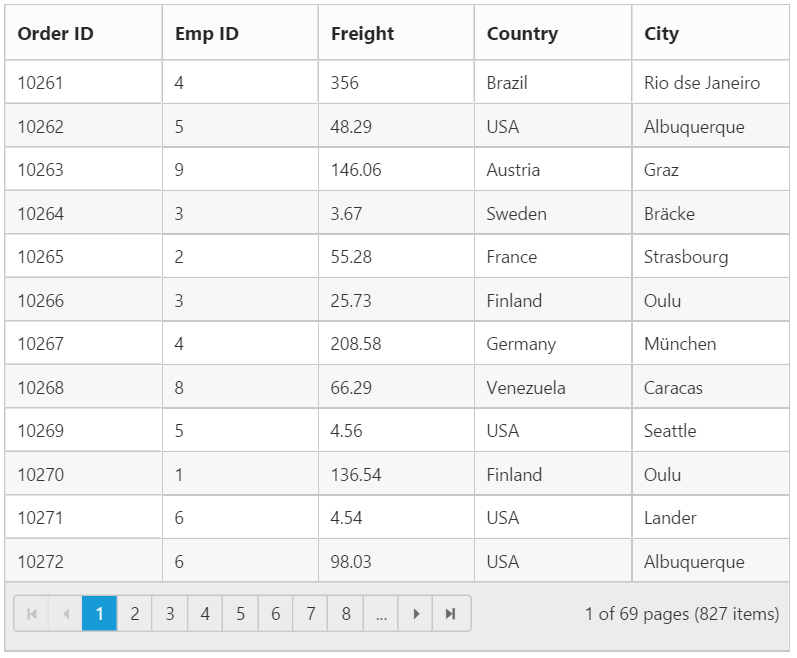
Header Text alignment
Align the header text of column header using HeaderTextAlign property of Columns. There are four possible ways to align header text, they are
- Right
- Left
- Center
- Justify
The following code example describes the above behavior.
<asp:Content ID="BodyContent" ContentPlaceHolderID="MainContent" runat="server">
<ej:Grid ID="FlatGrid" runat="server" AllowPaging="true">
<Columns>
<ej:Column Field="OrderID" HeaderText="Order ID" />
<ej:Column Field="EmployeeID" HeaderText="Emp ID" HeaderTextAlign = "Right" />
<ej:Column Field="Freight" HeaderText="Freight"/>
<ej:Column Field="ShipCountry" HeaderText="Country" HeaderTextAlign = "Center"/>
<ej:Column Field="ShipCity" HeaderText="City" HeaderTextAlign = "Right" />
</Columns>
</ej:Grid>
</asp:Content>namespace WebSampleBrowser.Grid
{
public partial class _Default : Page
{
protected void Page_Load(object sender, EventArgs e)
{
var data = new NorthWindDataContext().Orders.ToList();
FlatGrid.DataSource = data;
FlatGrid.DataBind();
}
}
}The following output is displayed as a result of the above code example.
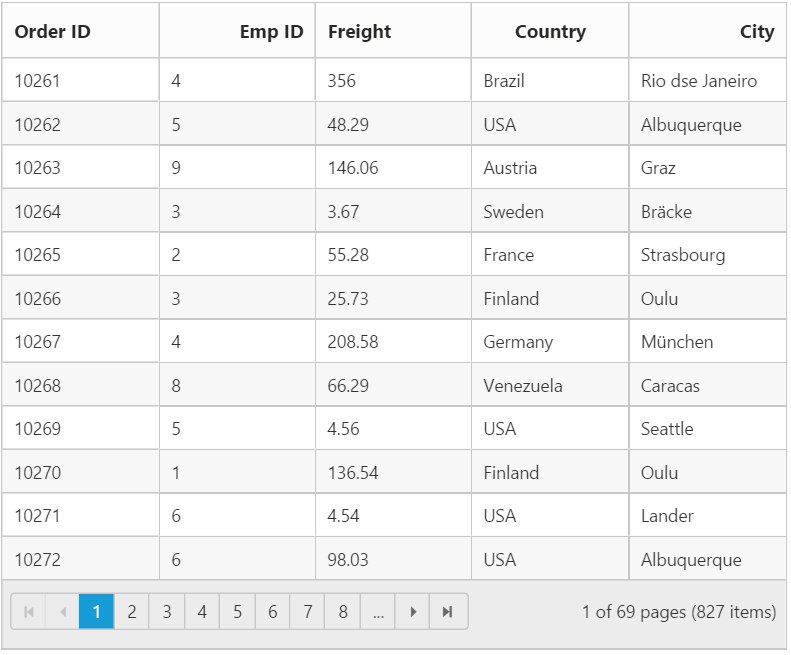
Header Template
The template design that applies on for the column header. To render template, set HeaderTemplateID property of the Columns.
You can use JsRender syntax in the template. For more information about JsRender syntax, please refer the link.
NOTE
It’s a standard way to enclose the
templatewithin thescripttag withtypeastext/x-jsrender.
The following code example describes the above behavior.
<asp:Content ID="BodyContent" ContentPlaceHolderID="MainContent" runat="server">
<ej:Grid ID="FlatGrid" runat="server" AllowPaging="true">
<Columns>
<ej:Column Field="OrderID" HeaderText="Order ID" />
<ej:Column Field="EmployeeID" HeaderText="Emp ID" HeaderTemplateID="#empTemplate" />
<ej:Column Field="Freight" HeaderText="Freight" />
<ej:Column Field="ShipCountry" HeaderText="Country" />
<ej:Column Field="ShipCity" HeaderText="City" />
</Columns>
</ej:Grid>
</asp:Content><script type="text/template" id="empTemplate">
Emp ID
<span class="e-userlogin e-icon employee"></span>
</script>namespace WebSampleBrowser.Grid
{
public partial class _Default : Page
{
protected void Page_Load(object sender, EventArgs e)
{
var data = new NorthWindDataContext().Orders.ToList();
FlatGrid.DataSource = data;
FlatGrid.DataBind();
}
}
}The following output is displayed as a result of the above code example.
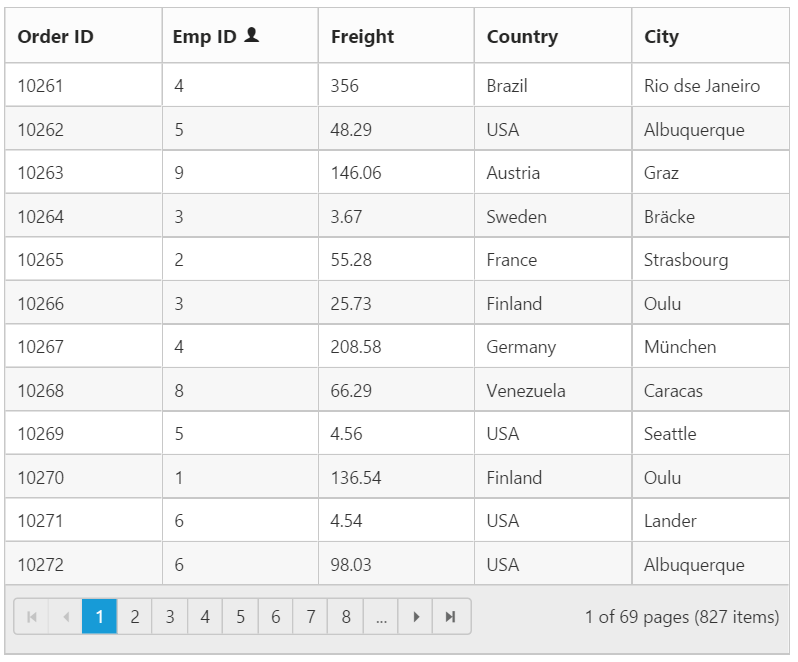
Text alignment
You can Align both content and header text of particular column using TextAlign property of Columns. There are four possible ways to align content and header text of column, they are
- Right
- Left
- Center
- Justify
NOTE
- The
TextAlignproperty will affect both content and header text of the grid.
The following code example describes the above behavior.
<asp:Content ID="BodyContent" ContentPlaceHolderID="MainContent" runat="server">
<ej:Grid ID="FlatGrid" runat="server" AllowPaging="true">
<Columns>
<ej:Column Field="OrderID" TextAlign="Right" />
<ej:Column Field="EmployeeID" TextAlign="Right" />
<ej:Column Field="Freight" TextAlign="Right" />
<ej:Column Field="ShipCountry" TextAlign="Center" />
<ej:Column Field="ShipCity" TextAlign="Justify" />
</Columns>
</ej:Grid>
</asp:Content>namespace WebSampleBrowser.Grid
{
public partial class _Default : Page
{
protected void Page_Load(object sender, EventArgs e)
{
var data = new NorthWindDataContext().Orders.ToList();
FlatGrid.DataSource = data;
FlatGrid.DataBind();
}
}
}The following output is displayed as a result of the above code example.
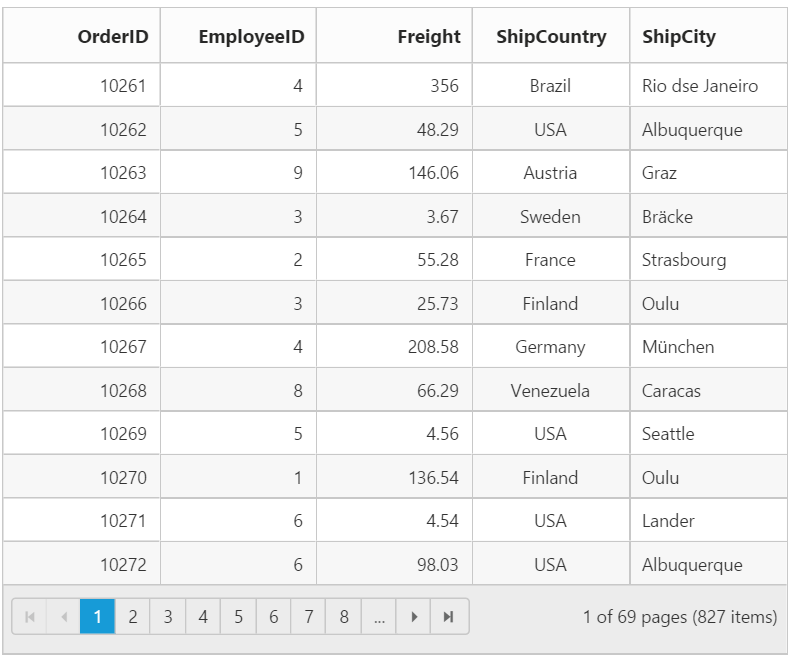
Format
Format is the process of customizing the particular column data with specified jQuery recognized globalize formats, such as currency, numeric, decimal, percentage or dates. The globalize format can be specified by using Format property of Columns.
The Format value should be wrapped within “{0:” and “}”. (For ex: “{0:C3}”). The data format strings are available for the Date and Number types.
The following code example describes the above behavior.
<asp:Content ID="BodyContent" ContentPlaceHolderID="MainContent" runat="server">
<ej:Grid ID="FlatGrid" runat="server" AllowPaging="true">
<Columns>
<ej:Column Field="OrderID" />
<ej:Column Field="EmployeeID" />
<ej:Column Field="Freight" Format="{0:C2}" />
<ej:Column Field="OrderDate" Format="{0:dd/MM/yyyy}"/>
<ej:Column Field="ShipCity"/>
</Columns>
</ej:Grid>
</asp:Content>namespace WebSampleBrowser.Grid
{
public partial class _Default : Page
{
protected void Page_Load(object sender, EventArgs e)
{
var data = new NorthWindDataContext().Orders.ToList();
FlatGrid.DataSource = data;
FlatGrid.DataBind();
}
}
}The following output is displayed as a result of the above code example.
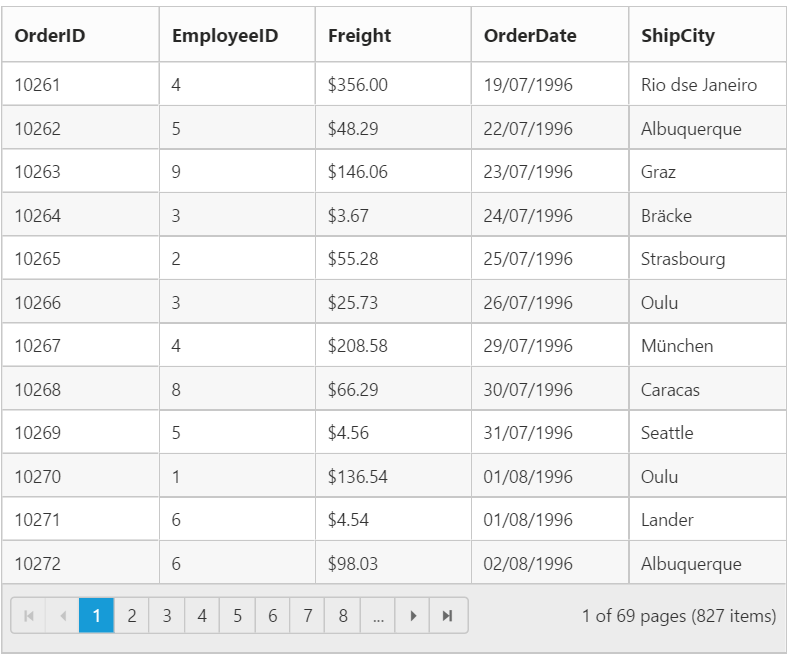
Width
You can specify the width for particular column by setting Width property of Columns as in pixel (ex: 100) or in percentage (ex: 40%).
The following code example describes the above behavior.
<asp:Content ID="BodyContent" ContentPlaceHolderID="MainContent" runat="server">
<ej:Grid ID="FlatGrid" runat="server" AllowPaging="true">
<Columns>
<ej:Column Field="OrderID" Width="10%" />
<ej:Column Field="EmployeeID" Width="15%" />
<ej:Column Field="Freight" Width="100" />
<ej:Column Field="ShipCity" Width="150" />
<ej:Column Field="ShipCountry" Width="100" />
</Columns>
</ej:Grid>
</asp:Content>namespace WebSampleBrowser.Grid
{
public partial class _Default : Page
{
protected void Page_Load(object sender, EventArgs e)
{
var data = new NorthWindDataContext().Orders.ToList();
FlatGrid.DataSource = data;
FlatGrid.DataBind();
}
}
}The following output is displayed as a result of the above code example.
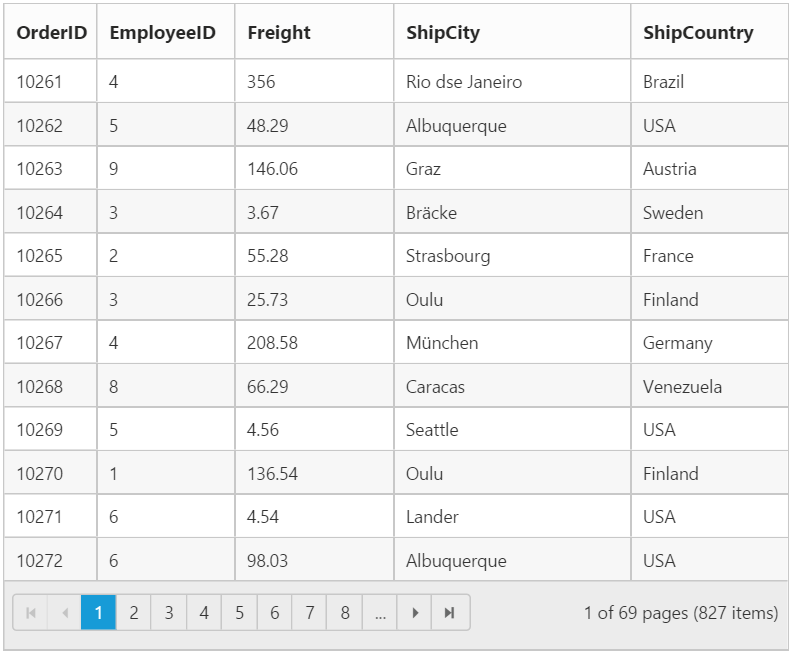
Resizing
The AllowResizing property enables the grid to set the width to columns based on resizing the grid column manually.
Resizing modes
ResizeMode property of ResizeSettings is used to change the resizing modes. It indicates whether to define mode of resizing.
| Name | Description |
|---|---|
| Normal | New column size will be adjusted by all other Columns |
| NextColumn | New column Size will be adjusted using next column. |
| Control | New column Size will be adjusted using entire control |
The following code example describes the above behavior.
<asp:Content runat="server" ID="BodyContent" ContentPlaceHolderID="MainContent">
<ej:Grid ID="Grid" runat="server" ClientIDMode="Static" AllowPaging="true" AllowResizing="true">
<ResizeSettings ResizeMode="NextColumn"></ResizeSettings>
<Columns>
<ej:Column Field="ShipCity" HeaderText="Ship City" Width="80"/>
<ej:Column Field="ShipPostalCode" HeaderText="Ship Postal Code" Width="40"/>
<ej:Column Field="ShipName" HeaderText="Ship Name" Width="40"/>
<ej:Column Field="ShipAddress" HeaderText="Ship Address" Width="100" />
</Columns>
<ClientSideEvents TemplateRefresh="refresh" />
</ej:Grid>
</asp:Content>namespace WebSampleBrowser.Grid
{
public partial class _Default : Page
{
List<Orders> order = new List<Orders>();
protected void Page_Load(object sender, EventArgs e)
{
this.Grid.DataSource = order;
this.Grid.DataBind();
}
}
}Resize to fit
The AllowResizeToFit property enable the Grid to set width to columns based on maximum width of the particular column’s content to facilitate full visibility of data in all the grid rows. This automatic behavior is applicable only for the columns which does not have width specified.
On columns where “width is defined”, double click on the particular column header’s resizer symbol to resize the column to show the whole text. For example, refer the “ShipCity” column in the below code snippet and output screen shot.
The following code example describes the above behavior.
<asp:Content ID="BodyContent" ContentPlaceHolderID="MainContent" runat="server">
<ej:Grid ID="FlatGrid" runat="server" AllowPaging="true" AllowResizeToFit="true">
<Columns>
<ej:Column Field="OrderID" Width="100" />
<ej:Column Field="EmployeeID" />
<ej:Column Field="Freight" Width="75" />
<ej:Column Field="ShipCity" Width="50" />
<ej:Column Field="ShipAddress" />
</Columns>
</ej:Grid>
</asp:Content>namespace WebSampleBrowser.Grid
{
public partial class _Default : Page
{
protected void Page_Load(object sender, EventArgs e)
{
var data = new NorthWindDataContext().Orders.ToList();
FlatGrid.DataSource = data;
FlatGrid.DataBind();
}
}
}The following output is displayed as a result of the above code example.
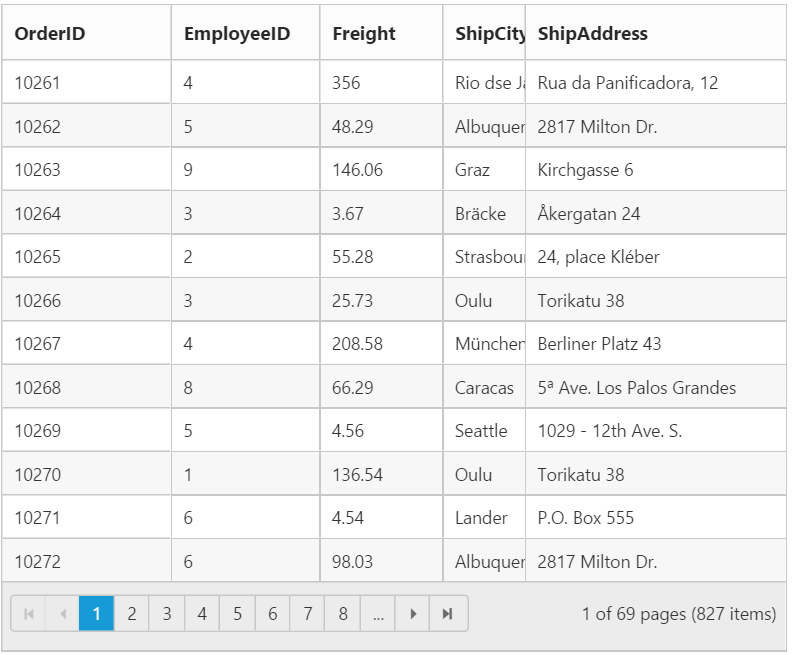
Reorder
Reordering can be done by drag and drop the particular column header from one index to another index within the Grid. Reordering can be enabled by setting AllowReordering property as true.
The following code example describes the above behavior.
</asp:Content>
<asp:Content ID="BodyContent" ContentPlaceHolderID="MainContent" runat="server">
<ej:Grid ID="FlatGrid" runat="server" AllowPaging="true" AllowReordering="true">
<Columns>
<ej:Column Field="OrderID" />
<ej:Column Field="EmployeeID" />
<ej:Column Field="ShipCity" />
<ej:Column Field="ShipCountry" />
<ej:Column Field="Freight" />
</Columns>
</ej:Grid>
</asp:Content>namespace WebSampleBrowser.Grid
{
public partial class _Default : Page
{
protected void Page_Load(object sender, EventArgs e)
{
var data = new NorthWindDataContext().Orders.ToList();
FlatGrid.DataSource = data;
FlatGrid.DataBind();
}
}
}The following output is displayed as a result of the above code example.
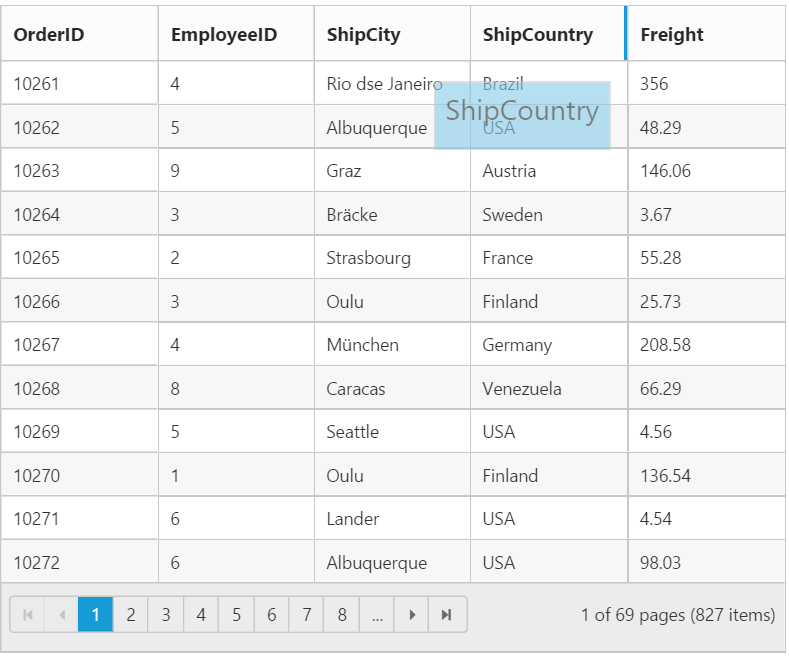
Visibility
You can hide particular column in Grid view by setting Visible property of it as false.
The following code example describes the above behavior.
<asp:Content ID="BodyContent" ContentPlaceHolderID="MainContent" runat="server">
<ej:Grid ID="FlatGrid" runat="server" AllowPaging="true">
<Columns>
<ej:Column Field="EmployeeID" />
<ej:Column Field="OrderID" Visible="false" />
<ej:Column Field="Freight" />
<ej:Column Field="ShipCity" />
<ej:Column Field="ShipCountry" />
</Columns>
</ej:Grid>
</asp:Content>namespace WebSampleBrowser.Grid
{
public partial class _Default : Page
{
protected void Page_Load(object sender, EventArgs e)
{
var data = new NorthWindDataContext().Orders.ToList();
FlatGrid.DataSource = data;
FlatGrid.DataBind();
}
}
}The following output is displayed as a result of the above code example.
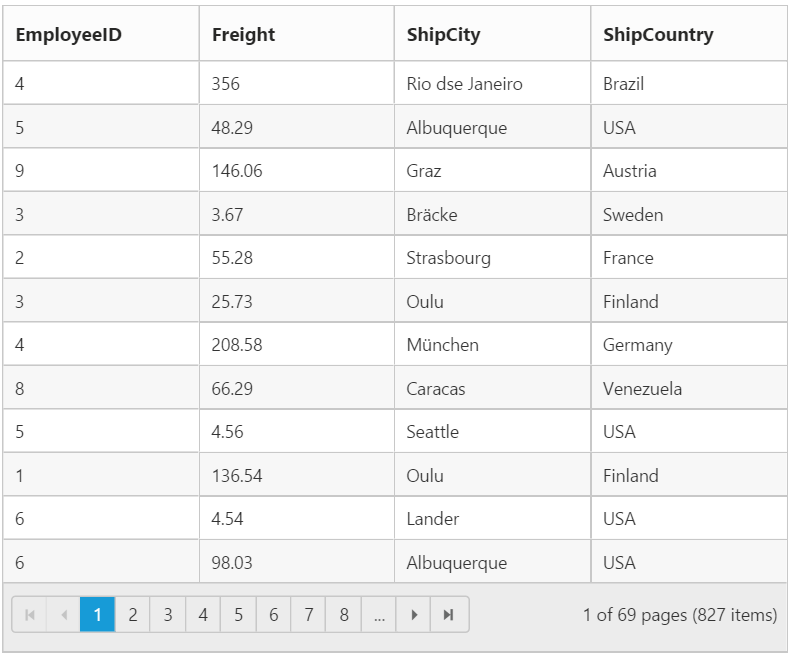
Unbound Column
You can define the unbound columns in Grid by not defining Field property for that particular column. Value for these columns can be populated either manually using QueryCellInfo event or by using column Template or by column Format property.
NOTE
Editing, grouping, filtering, sorting, summary and searching support are not available for unbound columns.
The following code example describes the above behavior.
<asp:Content ID="BodyContent" ContentPlaceHolderID="MainContent" runat="server">
<ej:Grid ID="FlatGrid" runat="server" AllowPaging="true">
<EditSettings AllowDeleting="True"></EditSettings>
<Columns>
<ej:Column Field="OrderID" IsPrimaryKey="true" />
<ej:Column Field="CustomerID" />
<ej:Column Field="EmployeeID" />
<ej:Column Field="Freight" />
<ej:Column HeaderText="" Format="<a onclick = click(this) href=#>Delete</a>" />
</Columns>
</ej:Grid>
</asp:Content><script type="text/javascript">
function click(e) {
var obj = $("#MainContent_FlatGrid").data("ejGrid");
obj.deleteRecord("OrderID", obj.getSelectedRecords()[0]);
}
</script>namespace WebSampleBrowser.Grid
{
public partial class _Default : Page
{
protected void Page_Load(object sender, EventArgs e)
{
var data = new NorthWindDataContext().Orders.ToList();
FlatGrid.DataSource = data;
FlatGrid.DataBind();
}
}
}The following output is displayed as a result of the above code example.
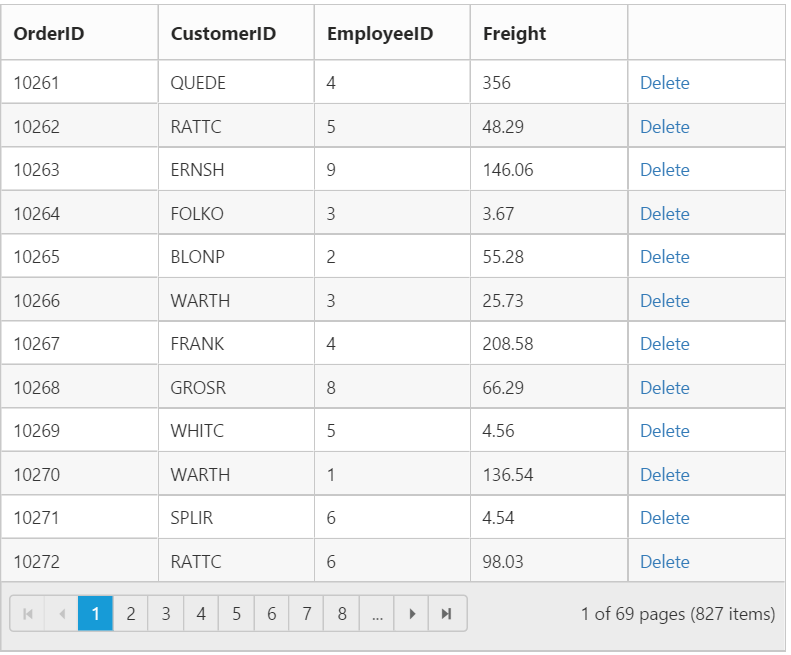
Column Template
HTML templates can be specified in the Template property of the particular column as a string (HTML element) or ID of the template’s HTML element.
You can use JsRender syntax in the template. For more information about JsRender syntax, please refer this link.
For template manipulation using JavaScript, either you can use JsRender helper function or TemplateRefresh grid event. For more information on TemplateRefresh event, refer this link.
NOTE
If
Fieldis not specified, you will not able to perform editing, grouping, filtering, sorting, search and summary functionalities in particular column.
The following code example describes the above behavior.
<asp:Content ID="BodyContent" ContentPlaceHolderID="MainContent" runat="server">
<ej:Grid ID="FlatGrid" runat="server" AllowPaging="true">
<PageSettings PageSize="4"></PageSettings>
<Columns>
<ej:Column HeaderText="Photo" Template="<img style='width: 75px; height: 70px' src='/13.2.0.29/themes/web/images/employees/.png' alt='.png' />" TextAlign="Center" />
<ej:Column Field="EmployeeID" />
<ej:Column Field="FirstName" />
<ej:Column Field="LastName" />
<ej:Column Field="Country" />
</Columns>
</ej:Grid>
</asp:Content>namespace WebSampleBrowser.Grid
{
public partial class _Default : Page
{
List<Orders> order = new List<Orders>();
protected void Page_Load(object sender, EventArgs e)
{
BindDataSource();
}
private void BindDataSource()
{
order.Add(new Orders(1, "Nancy", "Davolio", "USA"));
order.Add(new Orders(2, "Andrew", "Fuller", "USA"));
order.Add(new Orders(3, "Janet", "Leverling", "USA"));
order.Add(new Orders(4, "Margaret", "Peacock", "USA"));
order.Add(new Orders(5, "Steven", "Buchanan", "UK"));
order.Add(new Orders(6, "Michael", "Suyama", "UK"));
order.Add(new Orders(7, "Robert", "King", "UK"));
order.Add(new Orders(8, "Laura", "Callahan","USA"));
this.FlatGrid.DataSource = order;
this.FlatGrid.DataBind();
}
[Serializable]
public class Orders
{
public Orders()
{
}
public Orders(int EmployeeId, string FirstName, string LastName, string Country)
{
this.EmployeeID = EmployeeId;
this.FirstName = FirstName;
this.LastName = LastName;
this.Country = Country;
}
public int EmployeeID { get; set; }
public string FirstName { get; set; }
public string LastName { get; set; }
public string Country { get; set; }
}
}
}The following output is displayed as a result of the above code example.
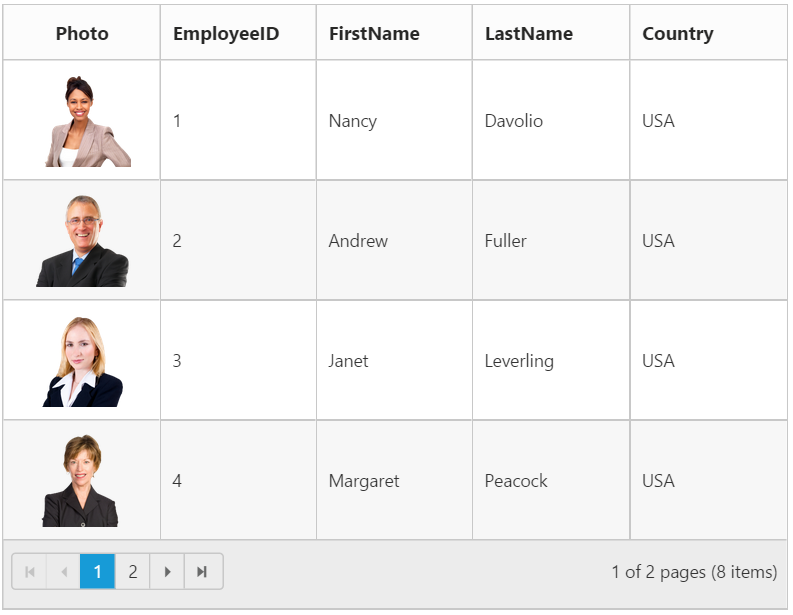
Controlling Grid actions
You can control the Grid actions of a particular column by setting AllowSorting, AllowGrouping, AllowFiltering, AllowResizing and AllowEditing properties.
The following code example describes the above behavior.
<asp:Content ID="BodyContent" ContentPlaceHolderID="MainContent" runat="server">
<ej:Grid ID="FlatGrid" runat="server" AllowPaging="true" AllowFiltering="true" AllowGrouping="true" AllowSorting="true" AllowResizing="true">
<EditSettings AllowEditing="True"></EditSettings>
<Columns>
<ej:Column Field="OrderID" IsPrimaryKey="true" />
<ej:Column Field="EmployeeID" AllowEditing="true" AllowGrouping="true" AllowFiltering="true" AllowSorting="true" AllowResizing="true" />
<ej:Column Field="Freight" />
<ej:Column Field="ShipCity" />
<ej:Column Field="ShipCountry" />
</Columns>
</ej:Grid>
</asp:Content>namespace WebSampleBrowser.Grid
{
public partial class _Default : Page
{
protected void Page_Load(object sender, EventArgs e)
{
var data = new NorthWindDataContext().Orders.ToList();
FlatGrid.DataSource = data;
FlatGrid.DataBind();
}
}
}Read only
To make a column as “read-only” then set AllowEditing property of Columns as false.
The following code example describes the above behavior.
<asp:Content ID="BodyContent" ContentPlaceHolderID="MainContent" runat="server">
<ej:Grid ID="FlatGrid" runat="server" AllowPaging="true">
<EditSettings AllowEditing="True"></EditSettings>
<Columns>
<ej:Column Field="OrderID" IsPrimaryKey="true" />
<ej:Column Field="EmployeeID" AllowEditing="false" />
<ej:Column Field="Freight" />
<ej:Column Field="ShipCity" />
<ej:Column Field="ShipCountry" />
</Columns>
</ej:Grid>
</asp:Content>namespace WebSampleBrowser.Grid
{
public partial class _Default : Page
{
protected void Page_Load(object sender, EventArgs e)
{
var data = new NorthWindDataContext().Orders.ToList();
FlatGrid.DataSource = data;
FlatGrid.DataBind();
}
}
}The following output is displayed as a result of the above code example.
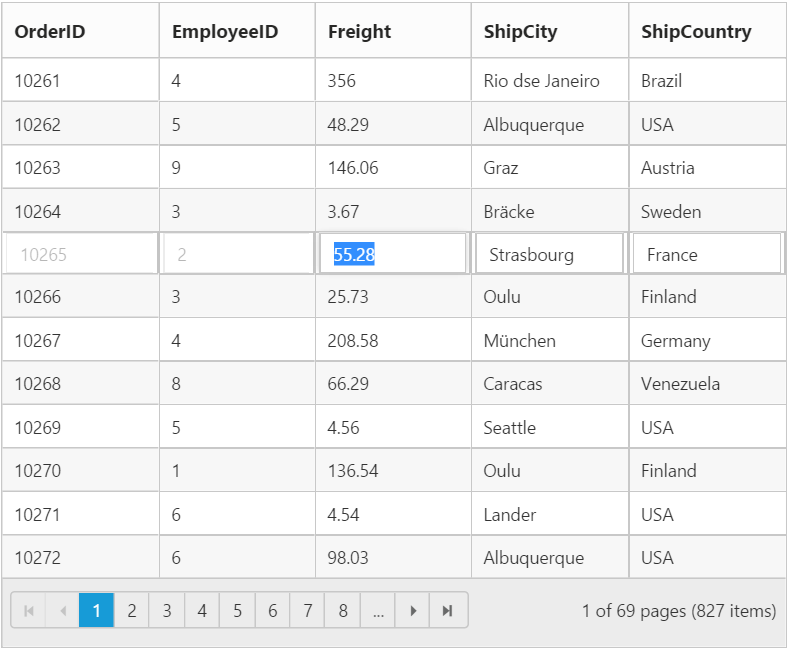
Expression Column
Expression column is possible only for Template column.
You can use JsRender syntax in the template.For more information about JsRender syntax, please refer the link.
NOTE
This expression column is supported at read only mode.
The following code example describes the above behavior.
<asp:Content ID="BodyContent" ContentPlaceHolderID="MainContent" runat="server">
<ej:Grid ID="FlatGrid" runat="server" AllowPaging="true">
<EditSettings AllowEditing="true"></EditSettings>
<Columns>
<ej:Column Field="FoodName" />
<ej:Column Field="Protein" />
<ej:Column Field="Fat" />
<ej:Column Field="Carbohydrate" />
<ej:Column HeaderText="Calories In Take" Template="<span>{{:Protein * 4 + Fat * 4 + Carbohydrate * 9 }}</span>" />
</Columns>
</ej:Grid>
</asp:Content>namespace WebSampleBrowser.Grid
{
public partial class _Default : Page
{
List<Orders> order = new List<Orders>();
protected void Page_Load(object sender, EventArgs e)
{
BindDataSource();
}
private void BindDataSource()
{
order.Add(new Orders("CHEESE BURGER", 15, 15, 28));
order.Add(new Orders("PIZZA", 15, 9, 39));
order.Add(new Orders("CHICKEN NOODLE", 4, 2, 9));
order.Add(new Orders("YOGURT", 10, 2, 43));
order.Add(new Orders("BEEF SANDWICH", 22, 13, 34));
order.Add(new Orders("CHICKEN BURGER", 15, 10, 25));
this.FlatGrid.DataSource = order;
this.FlatGrid.DataBind();
}
[Serializable]
public class Orders
{
public Orders()
{
}
public Orders(string name, int protein, int fat, int carbohydrate)
{
this.FoodName = name;
this.Protein = protein;
this.Fat = fat;
this.Carbohydrate = carbohydrate;
}
public string FoodName { get; set; }
public int Protein { get; set; }
public int Fat { get; set; }
public int Carbohydrate { get; set; }
}
}
}The following output is displayed as a result of the above code example.
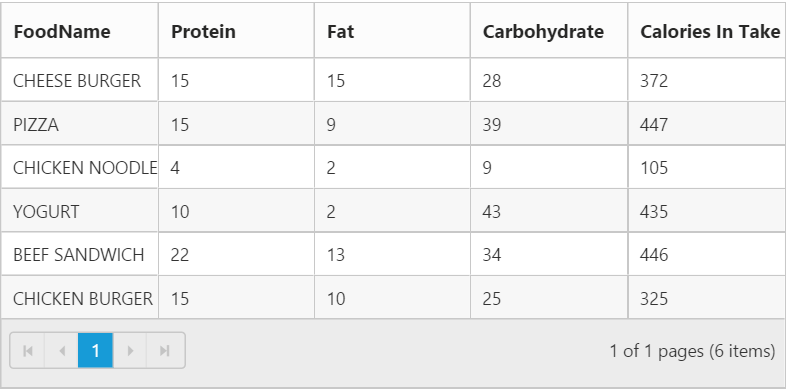
Command Column
Default action buttons
Using Command column, you can add CRUD action buttons as one of the Grid column, through Type property of Commands. The type property supports the below default UnboundType buttons.
- Edit
- Save
- Delete
- Cancel
Through ButtonOptions property of Commands, you can specify all the button options which are supported by Essential Studio ASP.NET Button control.
The following code example describes the above behavior.
<asp:Content ID="BodyContent" ContentPlaceHolderID="MainContent" runat="server">
<ej:Grid ID="FlatGrid" runat="server" AllowPaging="true">
<EditSettings AllowEditing="true" AllowAdding="true" AllowDeleting="true"></EditSettings>
<Columns>
<ej:Column Field="OrderID" IsPrimaryKey="true" />
<ej:Column Field="EmployeeID" />
<ej:Column Field="Freight" />
<ej:Column Field="ShipCountry" />
<ej:Column HeaderText="Manage Records" Width="130">
<Command>
<ej:Commands Type="edit">
<ButtonOptions Text="Edit"></ButtonOptions>
</ej:Commands>
<ej:Commands Type="delete">
<ButtonOptions Text="Delete"></ButtonOptions>
</ej:Commands>
<ej:Commands Type="save">
<ButtonOptions Text="Save"></ButtonOptions>
</ej:Commands>
<ej:Commands Type="cancel">
<ButtonOptions Text="Cancel"></ButtonOptions>
</ej:Commands>
</Command>
</ej:Column>
</Columns>
</ej:Grid>
</asp:Content>namespace WebSampleBrowser.Grid
{
public partial class _Default : Page
{
protected void Page_Load(object sender, EventArgs e)
{
var data = new NorthWindDataContext().Orders.ToList();
FlatGrid.DataSource = data;
FlatGrid.DataBind();
}
}
}The following output is displayed as a result of the above code example.
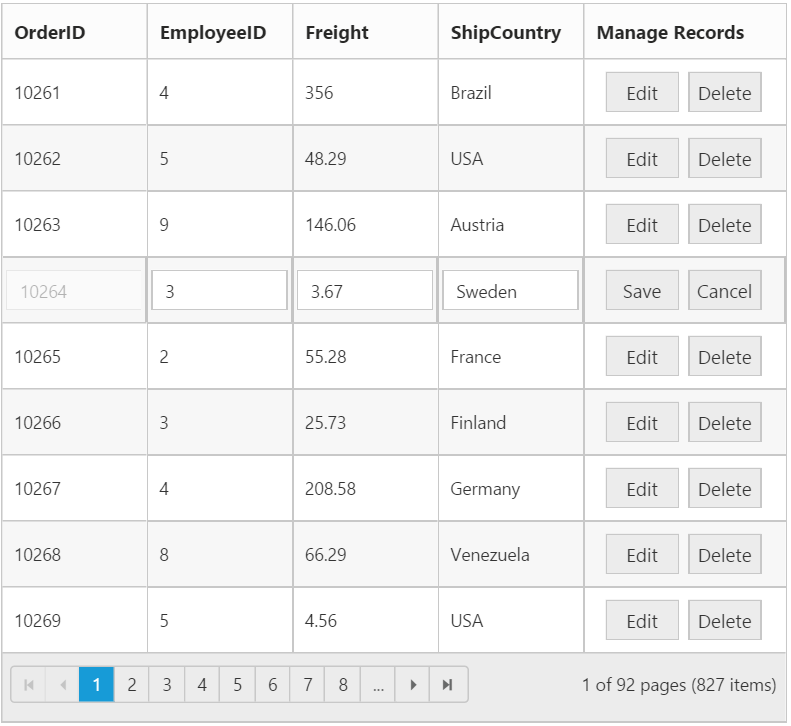
Custom buttons
You can add custom button in the command column by specifying the Type property of Commands as “empty” or any other string which does not corresponds to default UnboundType buttons.
NOTE
- In command column you can add only buttons.
The following code example describes the above behavior.
<asp:Content ID="BodyContent" ContentPlaceHolderID="MainContent" runat="server">
<ej:Grid ID="FlatGrid" runat="server" AllowPaging="true">
<EditSettings AllowEditing="true" AllowAdding="true" AllowDeleting="true"></EditSettings>
<Columns>
<ej:Column Field="EmployeeID" />
<ej:Column HeaderText="Employee Details" Width="130" TextAlign="Center">
<Command>
<ej:Commands Type="detail">
<ButtonOptions Text="Details" Width="100" Click="onClick"></ButtonOptions>
</ej:Commands>
</Command>
</ej:Column>
</Columns>
</ej:Grid>
</asp:Content><script type="text/javascript">
function onClick(args) {
var grid = $("#MainContent_FlatGrid").ejGrid("instance");
var index = this.element.closest("tr").index();
var record = grid.getCurrentViewData()[index];
alert("Record Details: " + JSON.stringify(record));
}
</script>namespace WebSampleBrowser.Grid
{
public partial class _Default : Page
{
protected void Page_Load(object sender, EventArgs e)
{
var data = new NorthWindDataContext().Orders.ToList();
FlatGrid.DataSource = data;
FlatGrid.DataBind();
}
}
}The following output is displayed as a result of the above code example.
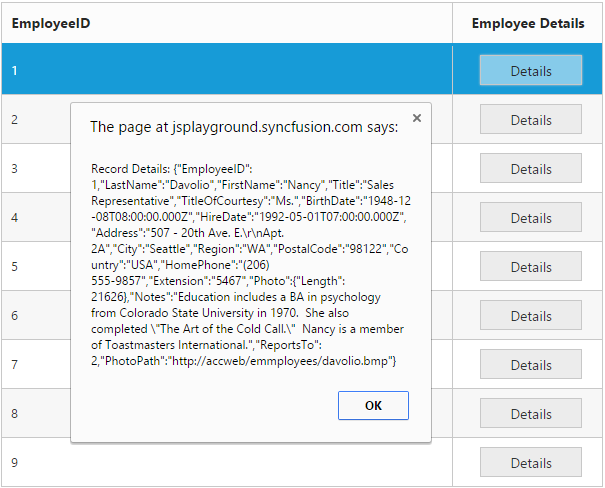
Column Chooser
Column chooser contains the list of all the columns which are defined in the Columns property. Using this you can control the visibility of columns in Grid. You can prevent to show the particular column name in column chooser by setting ShowInColumnChooser property of Columns as false.
Column Chooser would be shown in the top right corner of Grid. To enable column chooser, set ShowColumnChooser property as true.
The following code example describes the above behavior.
<asp:Content ID="BodyContent" ContentPlaceHolderID="MainContent" runat="server">
<ej:Grid ID="FlatGrid" runat="server" AllowPaging="true" ShowColumnChooser="true">
<Columns>
<ej:Column Field="OrderID" HeaderText="Order ID" />
<ej:Column Field="EmployeeID" HeaderText="Employee Name" ShowInColumnChooser="false" />
<ej:Column Field="Freight" HeaderText="Freight" />
<ej:Column Field="ShipCity" HeaderText="Ship City" />
<ej:Column Field="ShipCountry" HeaderText="Ship Country" />
</Columns>
</ej:Grid>
</asp:Content>namespace WebSampleBrowser.Grid
{
public partial class _Default : Page
{
protected void Page_Load(object sender, EventArgs e)
{
var data = new NorthWindDataContext().Orders.ToList();
FlatGrid.DataSource = data;
FlatGrid.DataBind();
}
}
}The following output is displayed as a result of the above code example.
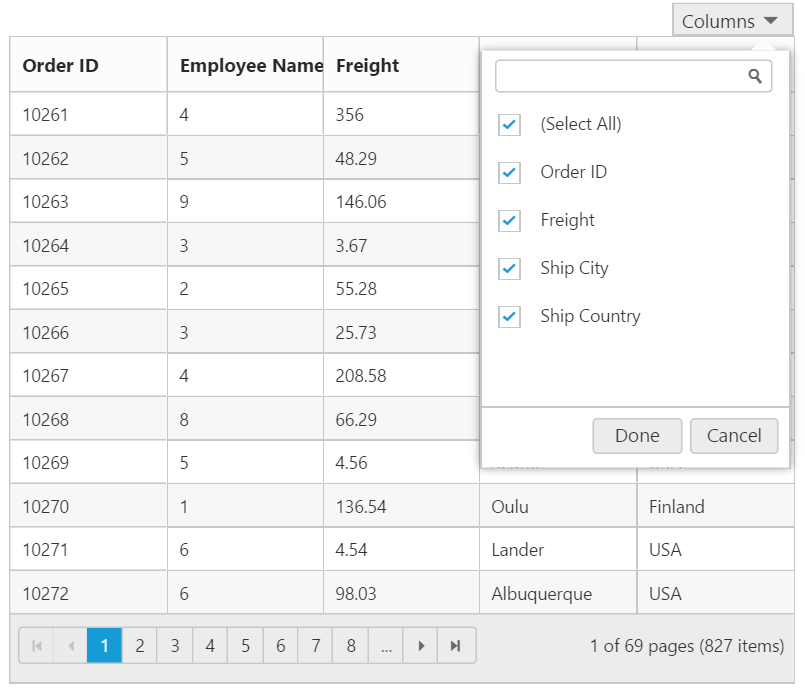
Foreign Key Column
Lookup data source can be bound to DataSource property of Columns. Data Field and Text can be set using ForeignKeyField and ForeignKeyValue property of Columns.
In the DataSource property, we can bound local and remote data.
IMPORTANT
For foreign key column the sorting and grouping is based on
ForeignKeyFieldinstead ofForeignKeyValue. You can refer Foreign Key Adaptor to sort and group the foreign key column based onForeignKeyValue.
NOTE
In remote data, server should be configured to perform select and filter operations since the Grid will try to fetch required columns using select operation and required data using filter operation.
The following code example describes the above behavior.
<asp:Content ID="BodyContent" ContentPlaceHolderID="MainContent" runat="server">
<ej:Grid ID="FlatGrid" runat="server" AllowPaging="true">
<EditSettings AllowEditing="true" AllowAdding="true" AllowDeleting="true"></EditSettings>
<Columns>
<ej:Column Field="OrderID" HeaderText="Order ID" />
<ej:Column Field="EmployeeID" HeaderText="Employee Name" ForeignKeyField="EmployeeID"
ForeignKeyValue="FirstName" TextAlign="Left" />
<ej:Column Field="Freight" HeaderText="Freight" />
<ej:Column Field="ShipCity" HeaderText="Ship City" />
<ej:Column Field="ShipCountry" HeaderText="Ship Country" />
</Columns>
</ej:Grid>
</asp:Content>namespace WebSampleBrowser.Grid
{
public partial class _Default : Page
{
List<Orders> order = new List<Orders>();
List<Employee> employee = new List<Employee>();
protected void Page_Load(object sender, EventArgs e)
{
BindDataSource();
}
private void BindDataSource()
{
int code = 10000;
for (int i = 1; i < 10; i++)
{
order.Add(new Orders(code + 1, "ALFKI", i + 2, 32.38, "Berlin", "Germany"));
order.Add(new Orders(code + 2, "ANATR", i + 1, 11.61, "Madrid", "Spain"));
order.Add(new Orders(code + 3, "ANTON", i + 4, 4.36, "Cholchester", "UK"));
order.Add(new Orders(code + 4, "BLONP", i + 1, 52.3, "Marseille", "France"));
order.Add(new Orders(code + 5, "BOLID", i + 3, 60.34, "Tsawassen", "Canada"));
code += 3;
}
this.FlatGrid.DataSource = order;
this.FlatGrid.DataBind();
employee.Add(new Employee(4, "Michael"));
employee.Add(new Employee(2, "Anne"));
employee.Add(new Employee(3, "Janet"));
employee.Add(new Employee(4, "Andrew"));
employee.Add(new Employee(5, "Margaret"));
employee.Add(new Employee(6, "Nancy"));
employee.Add(new Employee(7, "Robert"));
employee.Add(new Employee(8, "Laura"));
employee.Add(new Employee(9, "Steven"));
employee.Add(new Employee(10, "James"));
employee.Add(new Employee(11, "Smith"));
employee.Add(new Employee(12, "Johnson"));
employee.Add(new Employee(13, "George"));
var index = this.FlatGrid.Columns.FindIndex(col => col.Field == "EmployeeID");
this.FlatGrid.Columns.ElementAt(index).DataSource = employee;
//(or)
this.FlatGrid.Columns.ElementAt(index).DataSource = "http://mvc.syncfusion.com/Services/Northwnd.svc/Employees/";
}
[Serializable]
public class Orders
{
public Orders()
{
}
public Orders(long OrderId, string CustomerId, int EmployeeId, double Freight, string ShipCity, string ShipCountry)
{
this.OrderID = OrderId;
this.CustomerID = CustomerId;
this.EmployeeID = EmployeeId;
this.Freight = Freight;
this.ShipCity = ShipCity;
this.ShipCountry = ShipCountry;
}
public long OrderID { get; set; }
public string CustomerID { get; set; }
public int EmployeeID { get; set; }
public double Freight { get; set; }
public string ShipCity { get; set; }
public string ShipCountry { get; set; }
}
[Serializable]
public class Employee
{
public Employee()
{
}
public Employee(int EmployeeId, string FirstName)
{
this.EmployeeID = EmployeeId;
this.FirstName = FirstName;
}
public int EmployeeID { get; set; }
public string FirstName { get; set; }
}
}
}The following output is displayed as a result of the above code example.

Customize column
You can Customize the header and content of the particular column by CssClass property of the column.
The following code example describes the above behavior.
<style>
.customizes.e-headercell {
background-color: #2382c3;
color: white;
font-family: 'Bell MT';
font-size: 20px;
}
.customizes.e-rowcell {
background-color: #ecedee;
font-family: 'Bell MT';
color: red;
font-size: 20px;
}
</style><asp:Content ID="BodyContent" ContentPlaceHolderID="MainContent" runat="server">
<ej:Grid ID="FlatGrid" runat="server" AllowPaging="true">
<Columns>
<ej:Column Field="OrderID" />
<ej:Column Field="CustomerID" />
<ej:Column Field="EmployeeID" CssClass="customizes" />
<ej:Column Field="Freight" />
</Columns>
</ej:Grid>
</asp:Content>namespace WebSampleBrowser.Grid
{
public partial class _Default : Page
{
protected void Page_Load(object sender, EventArgs e)
{
var data = new NorthWindDataContext().Orders.ToList();
FlatGrid.DataSource = data;
FlatGrid.DataBind();
}
}
}The following output is displayed as a result of the above code example.
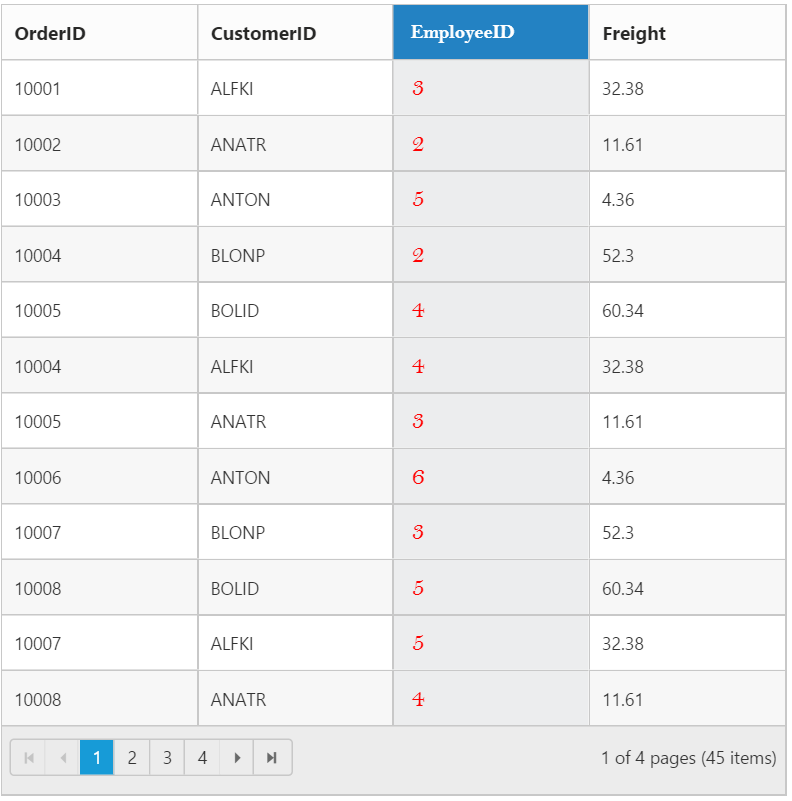
Type
Used to define the type of the particular column data. If the Type property of Columns is not specified then its type is automatically defined based on the first row data of that column.
NOTE
The
Typeis needed for filtering feature when first row of the data is “null” or “empty”.
The available column data type is tabulated as follows.
| Type | Description |
|---|---|
| string | Gets or sets the type of the column value as string |
| number | Gets or sets the type of the column value as number |
| date | Gets or sets the type of the column value as date |
| datetime | Gets or sets the type of the column value as datetime |
| boolean | Gets or sets the type of the column value as true or false |
| guid | Gets or sets the type of the column value as guid |
| checkbox | Gets or sets the type of the column value as checkbox for row selection |
The following code example describes the above behavior.
<asp:Content ID="BodyContent" ContentPlaceHolderID="MainContent" runat="server">
<ej:Grid ID="FlatGrid" runat="server" AllowPaging="true">
<Columns>
<ej:Column Field="OrderID" />
<ej:Column Field="CustomerID" Type="string" />
<ej:Column Field="EmployeeID" Type="number" />
<ej:Column Field="Freight" />
<ej:Column Field="ShipCountry" />
</Columns>
</ej:Grid>
</asp:Content>namespace WebSampleBrowser.Grid
{
public partial class _Default : Page
{
protected void Page_Load(object sender, EventArgs e)
{
var data = new NorthWindDataContext().Orders.ToList();
FlatGrid.DataSource = data;
FlatGrid.DataBind();
}
}
}The following output is displayed as a result of the above code example.

Column Layout
You can set the Grid’s columns layout based on either Grid width or its columns width using ColumnLayout property of Grid. There are two ways to set the column layout, they are
- Auto
- Fixed
<asp:Content ID="BodyContent" ContentPlaceHolderID="MainContent" runat="server">
<ej:Grid ID="FlatGrid" runat="server" AllowPaging="true" ColumnLayout="Fixed">
<Columns>
<ej:Column Field="OrderID" Width="80" />
<ej:Column Field="EmployeeID" Width="80" />
<ej:Column Field="ShipCity" Width="90" />
<ej:Column Field="ShipName" Width="110" />
<ej:Column Field="ShipCountry" Width="100" />
<ej:Column Field="Freight" Width="80" />
</Columns>
</ej:Grid>
</asp:Content>namespace WebSampleBrowser.Grid
{
public partial class _Default : Page
{
protected void Page_Load(object sender, EventArgs e)
{
var data = new NorthWindDataContext().Orders.ToList();
FlatGrid.DataSource = data;
FlatGrid.DataBind();
}
}
}The following output is displayed as a result of the above code example.
